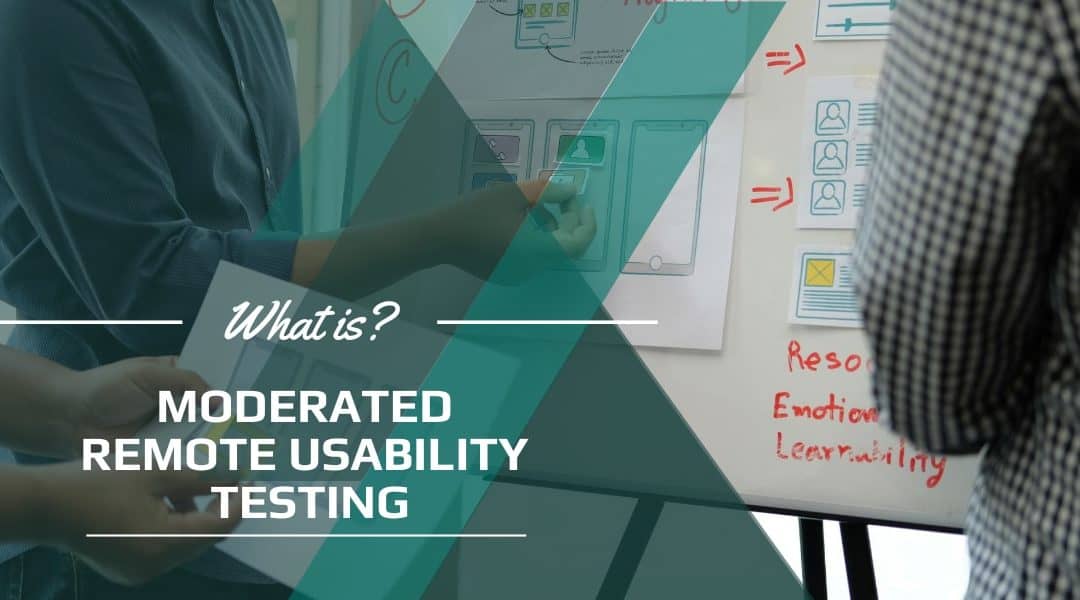Moderated remote usability testing is a process that allows for similar participants to test the same product without any of them physically being in the same location. This can be beneficial when you don’t have enough people to come into your office or want outside perspectives from different regions and countries.
With moderated remote usability testing, users with varying skill sets or backgrounds can participate in design reviews at a distance – allowing insights from diverse voices and viewpoints.
This article discusses how moderated remote usability testing works, including the benefits and drawbacks of this process, as well as a list of tools to help you do it.
What is moderated remote usability testing?
Moderated remote usability testing is a type of user testing in which one researcher observes and records the behaviors of subjects remotely located from the researcher.
Moderated remote testing is best done in a structured environment to get accurate results. In this case, you are observed while completing the tasks because it will allow for a more impartial observation of your task completion and performance. This type of usability test can be used when there is no defined sequence or steps that make up the task or for complex tasks that do not have one easily identifiable step.
Remote user testing offers an opportunity for participants from all over the world to collaborate on a single project. The moderator is responsible for guiding and directing each participant through the test scenario and facilitating their experience with it.
Moderated testing is beneficial because it allows companies to scale up or out by adding new moderators as necessary without changing anything about how they conduct tests remotely in general.
When to Consider Remote Testing
When the participants are geographically dispersed, the timeline can’t accommodate in-person testing, or they need to use a particular work machine due to software or security requirements.
When a site is complex or has a large number of pages, it may benefit from remote usability testing. Remote usability tests are conducted via the internet with no need for travel. They can provide more reliable results than conventional in-person surveys.
Remote usability testing is a great way to provide user feedback when you don’t have the resources or space for large-scale lab testing. Remote tests can be conducted in small groups, allowing more users to participate and providing opportunities for remote researchers who may not otherwise get access.
The cost of conducting remote usability test sessions is generally lower than those done in a traditional lab environment because they’re less expensive and allow your team members flexibility with their schedules.
Pros and cons of remote usability testing
Benefits of Remote Usability Testing
Remote usability testing allows for lower costs and eliminates travel expenses. It is less expensive than in-person testing, which requires a lab environment.
When conducting usability tests, remote testing allows for more participants than is usually not possible on-site. All you need is an internet connection and access to your target audience.
Companies can get insights into how their products perform in various geographies. They are also able to test with different devices and software platforms.
Remote usability testing is a unique option for those concerned about their privacy or anonymity. With remote usability, the participant can be tested remotely without giving any personal information.
Because of a larger number of participants, businesses can have more confidence in generalizing findings.
Challenges of Remote Usability Testing
Participants may be hesitant to speak up when they find it challenging to use the product.
Some factors may give false information to please the client. This includes providing wrong feedback on how a product should be improved or simply giving misleading data because of a lack of knowledge about the task at hand.

In-person vs remote
In-person testing is when the usability tester and participant are in the same room. On the other hand, remote testing is when the participant uses a computer or mobile device to interact with your product from another location.
Both methods have their strengths and weaknesses, but remote usability testing has several benefits that make it preferable for some companies.
Remote usability testing is the most cost- and time-effective way to test your product. It can be conducted without having individual participants physically in front of you, so testers don’t need to travel much for a remote session. In addition, this type of testing allows users who are not part of your team or company to participate in real-life scenarios where they may live far away from you and the target audience.
In-person usability testing effectively gathers data, but it can be difficult to assemble such a large number of participants. Remote usability tests are helpful when the target audience is too dispersed and there isn’t enough time or resources for an in-person test.
Remote usability testing also enables in-depth analysis because the data gathered can be analyzed at different points during the process.
This approach is more cost-effective than in-person tests, where one session may take longer due to travel costs or scheduling issues, which could lead to an inaccurate result and a lack of control over what happens during sessions.
Tools for moderated remote usability testing
You will need some tools to conduct a remote, moderated usability test. You need video equipment, sound recording devices, and internet or mobile data for the participants and moderator. There is also software necessary for effectively conducting the tests.
UserZoom
UserZoom is a moderated remote usability testing tool. It offers remote users the opportunity to test websites and apps without going through a lengthy process of training.
It offers usability benchmarking, tree testing, card testing, and surveys to help you build better software.
If you want to conduct remote usability testing, UserZoom is an excellent option. It offers study templates that help you get started with user interviews while using your app.
UserZoom is an analytics tool that helps companies analyze their website’s usability. The company also offers other analytics features in addition to usability tests, like heat maps and click maps.
Testbirds
Testbirds is a service that helps you find the right testers for your app. Testbirds help users gain a better understanding of how people use products and services. Testbirds also provides remote usability testing to test websites, smart devices, and wearables.
Testbirds is a website that provides real-time testing of your app with actual users. It allows you to test out the user interface and get instant feedback without any hassle.
They provide you with qualitative feedback on your final report. After submitting, Testbirds collects and evaluates the data to provide you with feedback.
UXCam
Using the website UXCam, you can quickly identify usability problems with your mobile app.
UXCam has features that make it helpful in understanding how users interact with your product in their natural environment over weeks and not just days.
The technology allows for real-time analytics, heatmaps, and session recordings to gain insight into what’s happening on the app.
How do you conduct moderated usability testing?
Planning and defining the specifics
You must thoroughly plan the test before you conduct it.
You need to know how many participants, where and when the test will be conducted, what type of questions will be asked during the testing session, and what kind of data is needed.
Before the first phase of a research project, it is important to understand what type of people you’re after. That way, you can plan out your proposal and define the specifics necessary for success in each phase.
When developing a product, it is essential to have clear goals.
Avoid broad terms such as “have users successfully log in.”
Instead, try to come up with a more specific goal. For example: “at least 80% of users need to login within 1 minute.”
Recruiting participants
You will most likely be recruiting people from all over. So screening them to ensure they are in the right demographic and show the desired behavioral traits is necessary.
If you decide to recruit participants, it is vital to consider the cost. Paying a third party or recruiting yourself will depend on your budget.
To successfully recruit participants into your study, you should consider using a quick and easy tool. Some tools have grown to be very advanced with built-in features for remote recruitment.
Preparing for moderation
Prepare for potential problems that can arise. This includes planning ahead and thinking about what you might need to do to mitigate any issues that may come up during the test.
Suppose you are moderating a test that will be taken by many people. In that case, it is important to plan for moderation and follow a checklist of common obstacles.
Moderators should run a pilot test before launching the test. The moderator needs to make sure everything fits well, is not too big, and can be accomplished quickly.
Write a test script
When conducting moderated remote usability testing, it is essential to write a test script. It should be broken down into three parts:
- contextual questions
- scenarios and tasks
- and questions about their experience.
The moderator can also use the script as a guide for how they would like to approach the interview with each participant.
When moderating, it is important to build rapport with the participants. Be sure to ask contextual questions that help participants feel more relaxed or comfortable during the test. Ask non-leading questions, and keep them open-ended.
First, you should write a test script or task list. Then, create scenarios that your users might encounter while using the app and direct a particular task for them to complete with the product. Finally, prepare follow-up questions about their experience.
Conduct the test
Send an email to all parties the night before or morning of testing that includes reminders about what will happen during the test and instructions for completing tasks.
To conduct the test, you will have one person who is facilitating and another observing and taking notes.
The moderator must create an atmosphere that is both comfortable and “real.” They should speak slowly, look into the camera, and remain in the frame throughout the test to avoid confusion.
The more feedback given throughout the testing process, the easier and quicker for both participants and evaluators to come up with valid conclusions.
Analyze and report results
Gather all the data, organize your thoughts, compare metrics with standards, and keep an eye on how it relates to your goals.
Analyze and compare your usability test results with your overall goals.
Avoid using any UX or design-specific language that your stakeholders might not understand.
Tips & best practices for moderated usability testing
Technology questions
When conducting remote usability testing, it’s important to research the technology used. This will allow you to create a more realistic test by adding questions about that technology during the interview.
Over-recruit
It is important to over-recruit for your user research project. Make sure you have enough participants by at least one or two, and consider telling a couple of the participants, “You’re our backup and will get a phone call if we need you.”
Send email reminders
Reminders are key to ensuring that your participant follows instructions and understand what you need from them. Tools like Calendly and YouCanBook.me automate reminders for remote usability tests, so it is easy to stay organized before the event begins.
Be considerate of time zones
When scheduling your reminder and booking confirmation emails, take into account time zones for the participant to be reminded in their own time.
Reset Times
The length of time between sessions will depend on the intensity of the usability test. For example, a moderator can allow 10 minutes for participants to reset and prepare for the next session.
Consent forms
Prepare consent forms and an NDA. Consent forms are used to gain the user’s permission while in the session, while NDAs protect both parties from legal repercussions.
You should always ensure you have these forms ready before recording your videos to avoid any awkward questions.
Make rescheduling and canceling an easy process
It is essential to provide a way for users to reschedule or cancel their sessions with the software. Make it easy for them to not be put in an awkward position when someone has to leave early.
FAQ
What’s the difference between moderated user testing and unmoderated user testing?
Moderated remote usability testing requires moderators to guide testers and answer their queries. Unmoderated usability testing offers little to no feedback, but if you want to observe and measure behavior patterns, use this type of testing.
How do you validate or test the usability of a design?
1. Plan and define the specifics and goals
2. Recruiting the right participants for UX research testing
3. Set up the testing environment
4. Conduct the testing
5. Analyze and report the results
What are moderated remote studies?
Moderated remote studies are a type of qualitative research study conducted in an online setting. Moderators may use any real-time screen-share technology to conduct the study.

